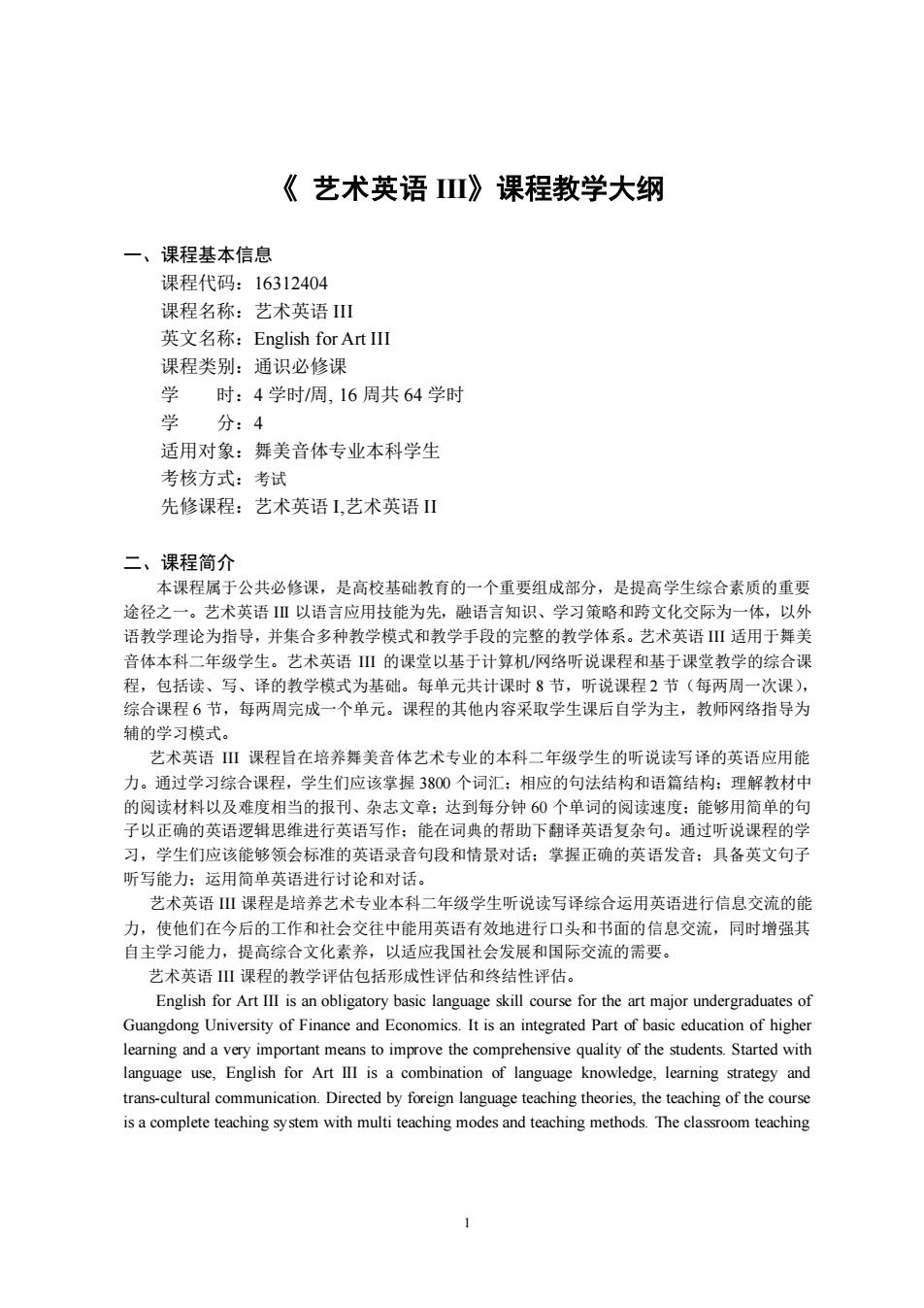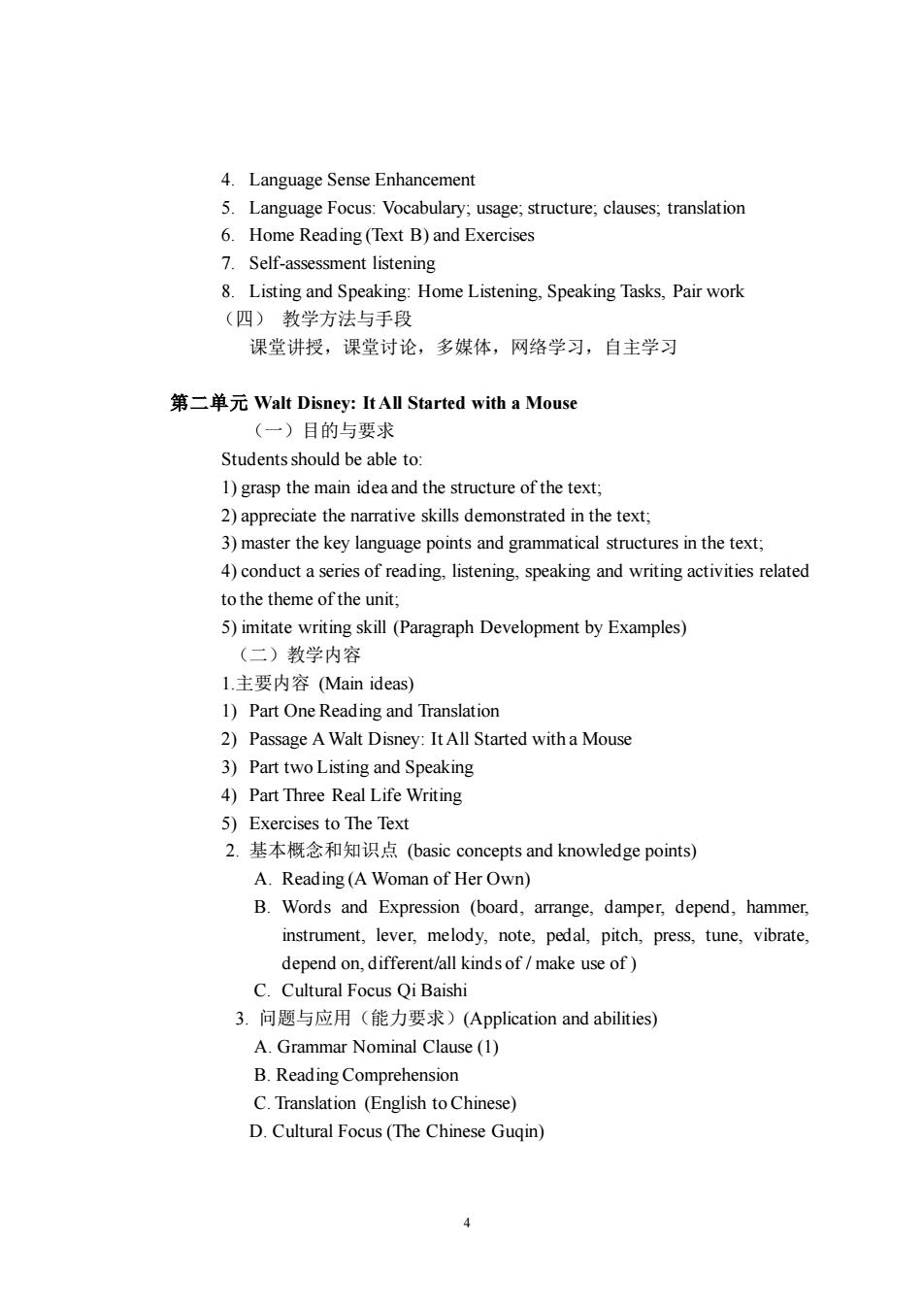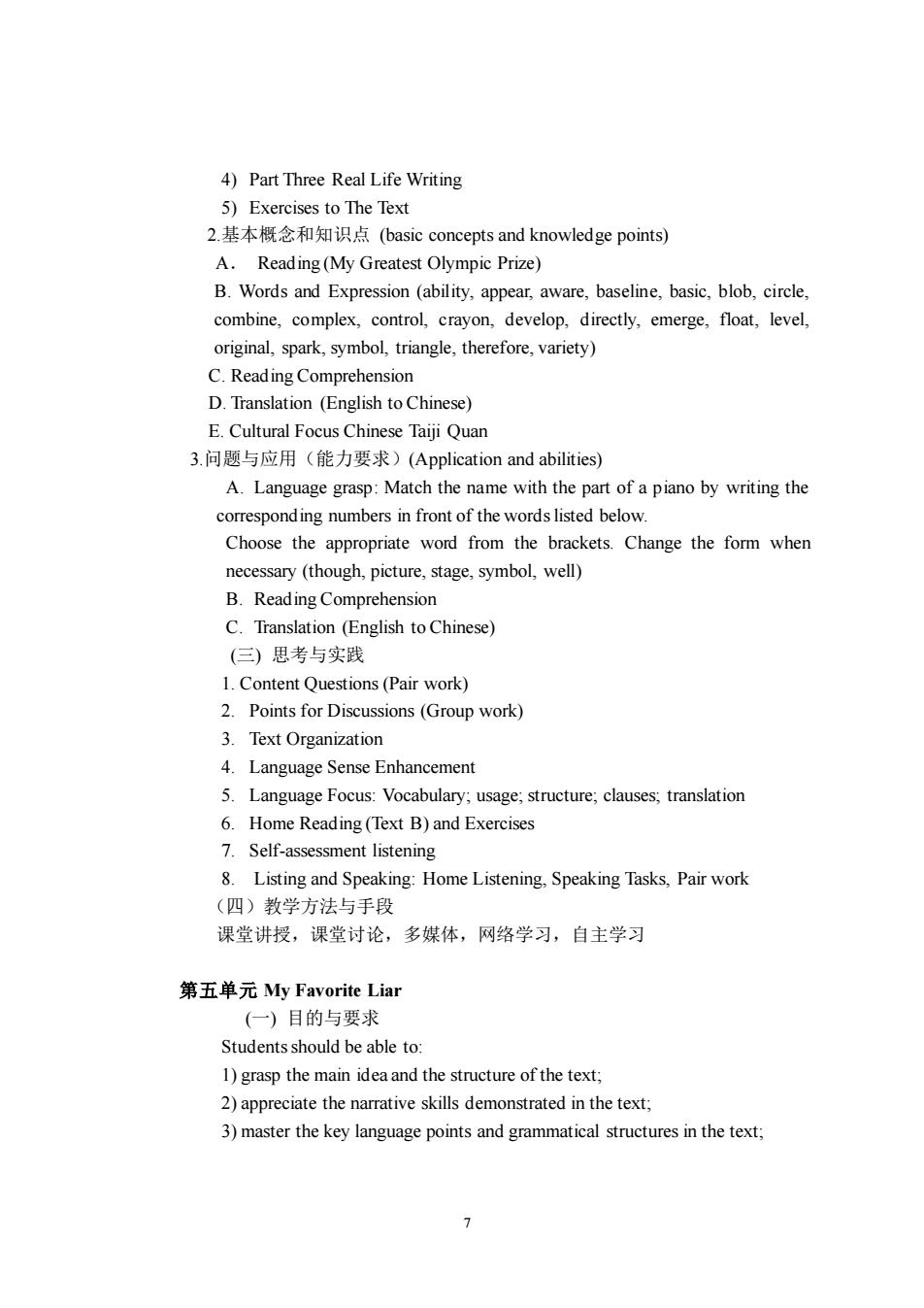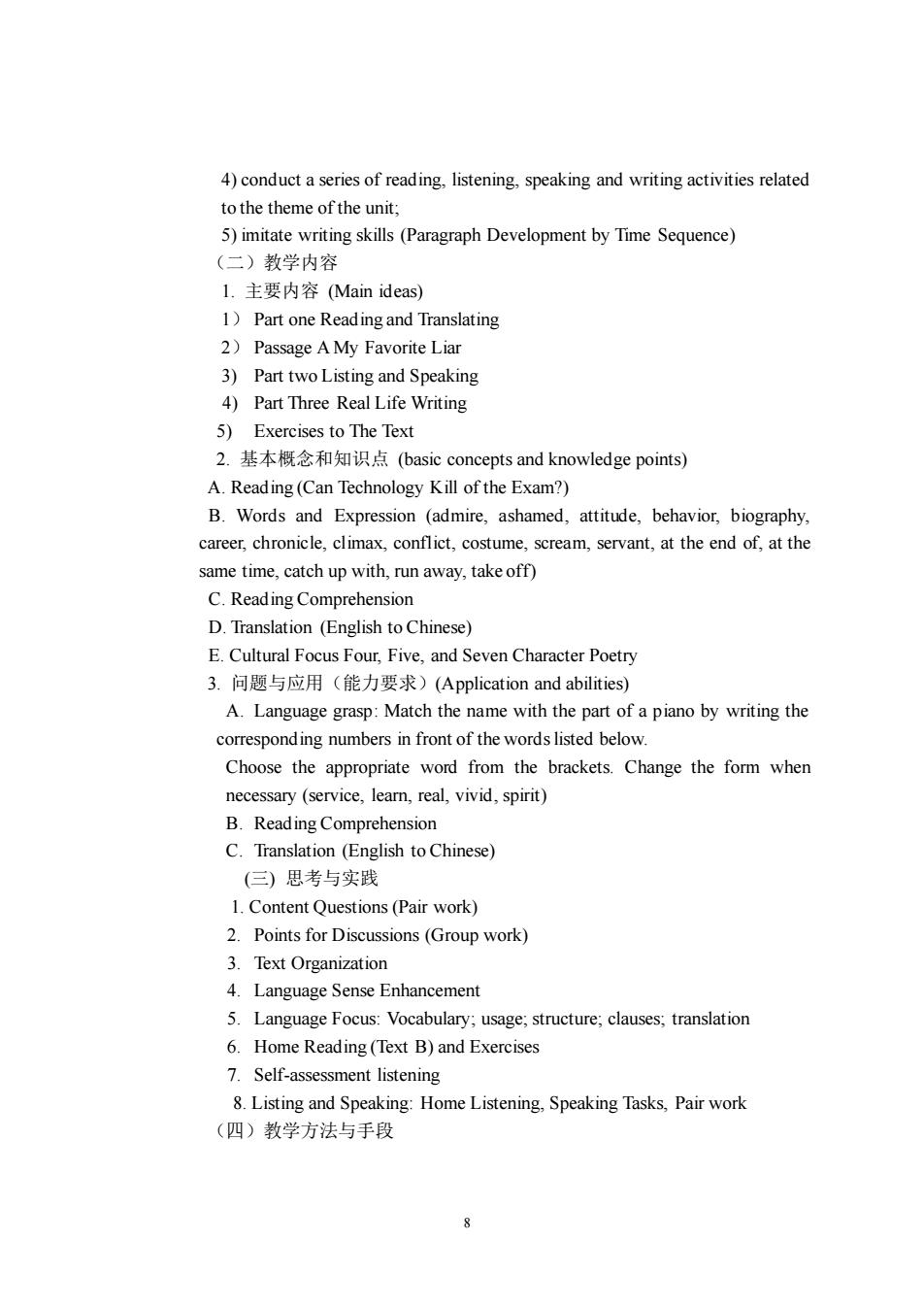
《艺术英语山》课程教学大纲 一、课程基本信息 课程代码:16312404 课程名称:艺术英语 英文名称:English for Art I 课程类别:通识必修课 学 时:4学时周,16周共64学时 学 分:4 适用对象:舞美音体专业本科学生 考核方式:考试 先修课程:艺术英语,艺术英语Ⅱ 二、课程简介 本课程属于公共必修课,是高校基础教有的一个重要组成部分,是提高学生综合素质的重要 途径之一。艺术英语Ⅲ以语言应用技能为先,融语言知识、学习策略和跨文化交际为一体,以外 语教学理论为指导,并集合多种教学模式和教学手段的完整的教学体系。艺术英语Ⅲ适用于舞美 音体本 二年级学生 艺术英 Ⅲ的课堂以基于计算机/网络听说课程和基 于课堂教学的综合 程,包括读、写、译的教学模式为基础。每单元共计课时8节,听说课程2节(每两周一次课) 综合课程6节,每两周完成一个单元。课程的其他内容采取学生课后自学为主,教师网络指导为 辅的学习模式。 艺术英语课程旨在培养舞美音体艺术专业的本科一年级学生的听说读写译的英语应用能 力。通过学习综合课程, 学生们应该掌握3800 词汇 相应的句法结构和语篇结构:理解教材 的阅读材料以及难度相当的报刊、杂志文章:达到每分钟60个单词的阅读速度:能够用简单的句 子以正确的英语逻辑思维进行英语写作:能在词典的帮助下翻译英语复杂句。通过听说课程的学 习,学生们应该能够领会标准的英语录音句段和情景对话:掌握正确的英语发音:具备英文句子 听写能力:运用简单英语进行讨论和对话。 艺术英语Ⅲ课程是培养艺术专业本科二年级学生听说读写译综合运用英语进行信息交流的能 使他们在今后的工作和社会交往中能用英语有效地进行口头和书面的信息交流,同时增强其 自主学习能力,提高综合文化素养,以适应我国社会发展和国际交流的需要。 艺术英语Ⅲ课程的教学评估包括形成性评估和终结性评估。 English for art ill is an obligatory basic language skill course for the art maior undergraduates of Guangdong University of Financ and Economics.It isan integrated Part of basi learning and a very important means to improve the comprehensive quality of the students.Started wit language use,English for Art I is a combination of language knowledge,learning strategy and trans-cultural communication.Directed by foreign language teaching theories,the teaching of the course is a complete teaching system with multi teaching modes and teaching methods.The classroom teaching
1 《 艺术英语 III》课程教学大纲 一、课程基本信息 课程代码:16312404 课程名称:艺术英语 III 英文名称:English for Art III 课程类别:通识必修课 学 时:4 学时/周, 16 周共 64 学时 学 分:4 适用对象:舞美音体专业本科学生 考核方式:考试 先修课程:艺术英语 I,艺术英语 II 二、课程简介 本课程属于公共必修课,是高校基础教育的一个重要组成部分,是提高学生综合素质的重要 途径之一。艺术英语 III 以语言应用技能为先,融语言知识、学习策略和跨文化交际为一体,以外 语教学理论为指导,并集合多种教学模式和教学手段的完整的教学体系。艺术英语 III 适用于舞美 音体本科二年级学生。艺术英语 III 的课堂以基于计算机/网络听说课程和基于课堂教学的综合课 程,包括读、写、译的教学模式为基础。每单元共计课时 8 节,听说课程 2 节(每两周一次课), 综合课程 6 节,每两周完成一个单元。课程的其他内容采取学生课后自学为主,教师网络指导为 辅的学习模式。 艺术英语 III 课程旨在培养舞美音体艺术专业的本科二年级学生的听说读写译的英语应用能 力。通过学习综合课程,学生们应该掌握 3800 个词汇;相应的句法结构和语篇结构;理解教材中 的阅读材料以及难度相当的报刊、杂志文章;达到每分钟 60 个单词的阅读速度;能够用简单的句 子以正确的英语逻辑思维进行英语写作;能在词典的帮助下翻译英语复杂句。通过听说课程的学 习,学生们应该能够领会标准的英语录音句段和情景对话;掌握正确的英语发音;具备英文句子 听写能力;运用简单英语进行讨论和对话。 艺术英语 III 课程是培养艺术专业本科二年级学生听说读写译综合运用英语进行信息交流的能 力,使他们在今后的工作和社会交往中能用英语有效地进行口头和书面的信息交流,同时增强其 自主学习能力,提高综合文化素养,以适应我国社会发展和国际交流的需要。 艺术英语 III 课程的教学评估包括形成性评估和终结性评估。 English for Art III is an obligatory basic language skill course for the art major undergraduates of Guangdong University of Finance and Economics. It is an integrated Part of basic education of higher learning and a very important means to improve the comprehensive quality of the students. Started with language use, English for Art III is a combination of language knowledge, learning strategy and trans-cultural communication. Directed by foreign language teaching theories, the teaching of the course is a complete teaching system with multi teaching modes and teaching methods. The classroom teaching

of the course includes computer-based listening and speaking part and classroom-based integrated part of reading,writing and translating.The completion of each unit needs 8 periods(2 weeks):2 periods for listening and speaking(every other week)and 6 periods for integrated part.The rest of the textbooks are to be self-studied by students after class with their teachers coaching them on-line. The integrated Part of English for Ar to English languageus in listening,speaking.reading.writing and translating.Having leamned the course,students are supposed to have a larger vocabulary (3800 words).grasp corresponding syntactic structures as well as textual structures,understand the reading material in textbooks as well as English newspapers and magazines of similar difficulty to those above mentioned material;read at a speed of 60 words a minute:write logic compo sition simple but grammat ect English sentences,transla complex English sentences into Chinese or vice versa with the help of dictionaries.Listening and speaking Part of the course can enable students to understand standard recorded English sentences, dialogues and speeches,grasp correct pronunciation,dictate simple English sentences,make brief self-introduction:and take part in discussions or dialogues in simple English. English for Art III is targeted to improve the listening.speaking,reading.writing and ranslating abilities of studentsso that they can be better prepared to have effective information exchange in English in their future work and social interactions.At the same time the self-study ability of students will also be enhanced and cultural quality developed so as to meet the needs of China's social development and international exchanges The evaluation of English for Art IlI conists of formative assessment and summative assessment 三、课程性质与教学目的 艺术英语Ⅲ级课程是为广东财经大学非英语专业的艺术类专业本科二年级学生开设的一门 语言技能基础课程,是广东财经大学非英语专业教学计划的一个有机组成部分,是一门提高艺术 专业学生综合人文素养的重要课程。 艺术英语Ⅲ级课程的学习,既是学生通过英语学习和实践活动逐步掌握英语知识和技能,提 高语言实际运用能力的过程,又是他们陶治情操,丰富人生经验,开发辩证思维能力和提高人文 素养的过程。它有助于学生拓展视野,扩大知识面,加深对世界的了解,借鉴和吸收优秀的外国 文化精华,提高文化素养。艺术英语Ⅲ课程是以英语语言知识与应用技巧,学习策略和跨文化交 际为主要内容,以外语教学理论为指导,并集多种教学模式和教学手段为一体的教学体系, 艺术英语Ⅲ级课程教学目的是:通过教师的“精讲”和学生的“多练”通过听说读写译全方 位的各种形式的课堂内外的实践,以多媒体技术为教学手段之一,培养学生的阅读能力和听说能 力,使他们能够运用英语交流信息,打下扎实的语言基础,掌握良好的语言学习方法,提高文化 素养,培养持续的自学能力,适应社会的需求和发展。 艺术英语Ⅲ级课程目标是1培养学生阅读和翻译艺术英语文献的能力,能够对涉及到音乐, 舞蹈,表演,动画,摄影及电影与电视等题材的文章进行阅读,让学生熟悉每篇文章体裁的特点
2 of the course includes computer-based listening and speaking part and classroom-based integrated part of reading, writing and translating. The completion of each unit needs 8 periods (2 weeks): 2 periods for listening and speaking (every other week) and 6 periods for integrated part. The rest of the textbooks are to be self-studied by students after class with their teachers coaching them on-line. The integrated Part of English for Art III aims to develop students’ abilities of English language use in listening, speaking, reading, writing and translating. Having learned the course, students are supposed to have a larger vocabulary (3800 words); grasp corresponding syntactic structures as well as textual structures; understand the reading material in textbooks as well as English newspapers and magazines of similar difficulty to those above mentioned material; read at a speed of 60 words a minute; write logically proper compositions with simple but grammatically correct English sentences; translate complex English sentences into Chinese or vice versa with the help of dictionaries. Listening and speaking Part of the course can enable students to understand standard recorded English sentences, dialogues and speeches; grasp correct pronunciation; dictate simple English sentences; make brief self-introduction; and take part in discussions or dialogues in simple English. English for Art III is targeted to improve the listening, speaking, reading, writing and translating abilities of students so that they can be better prepared to have effective information exchange in English in their future work and social interactions. At the same time the self-study ability of students will also be enhanced and cultural quality developed so as to meet the needs of China’s social development and international exchanges. The evaluation of English for Art III consists of formative assessment and summative assessment. 三、课程性质与教学目的 艺术英语 III 级课程是为广东财经大学非英语专业的艺术类专业本科二年级学生开设的一门 语言技能基础课程,是广东财经大学非英语专业教学计划的一个有机组成部分,是一门提高艺术 专业学生综合人文素养的重要课程。 艺术英语 III 级课程的学习,既是学生通过英语学习和实践活动逐步掌握英语知识和技能,提 高语言实际运用能力的过程,又是他们陶冶情操,丰富人生经验,开发辩证思维能力和提高人文 素养的过程。它有助于学生拓展视野,扩大知识面,加深对世界的了解,借鉴和吸收优秀的外国 文化精华,提高文化素养。艺术英语 III 课程是以英语语言知识与应用技巧,学习策略和跨文化交 际为主要内容,以外语教学理论为指导,并集多种教学模式和教学手段为一体的教学体系。 艺术英语 III 级课程教学目的是:通过教师的“精讲”和学生的“多练”通过听说读写译全方 位的各种形式的课堂内外的实践,以多媒体技术为教学手段之一,培养学生的阅读能力和听说能 力,使他们能够运用英语交流信息,打下扎实的语言基础,掌握良好的语言学习方法,提高文化 素养,培养持续的自学能力,适应社会的需求和发展。 艺术英语 III 级课程目标是 1.培养学生阅读和翻译艺术英语文献的能力,能够对涉及到音乐, 舞蹈,表演,动画,摄影及电影与电视等题材的文章进行阅读,让学生熟悉每篇文章体裁的特点

提高学生的写作能力:2.培养学生进行艺术领域涉外口语交际能力:3.培养学生参照范例用英语 模拟套写相关应用文的能力。 四、教学内容及要求 精读 第一单元The Violin in the Late-Afternoon Sun (一)目的与要求 Students should be able to: 1.grasp the main idea and the structure of the text; 2.appreciate the narrative skills demonstrated in the text; 3.master the key language points and grammatical structures in the text 4.conduct a series of reading,listening,speaking and writing activities related to the theme of the unit. 5.imitate writing skills(Topic Sentences) (二)教学内容 1.主要内容(Main ideas) 1)Part One Reading and Translating 2)Reading A The Violin in the Late-Afternoon Sun? 3)New Words and Useful Expressions 4)Exercises to The Text .基本概念和知识点(basic concepts and knowledge points) A.Reading(Life in a Violin Case) B.Words and Expression (arrangement,artistic,artwork,background, challenge,classical,common,a number of,add to,symphony,opera, emotion,sculpture,taste,remind sb.of) C.Cultural Focus The Chinese Guqin 2.问题与应用(能力要求)(Application and abilities) A.Subordinate Clause B.Reading Comprehension ability C.Translation(English to Chinese) D.Listening and Speaking 三)思老与实我 1.Content Ouestions (Pair work) 2.Points for Discussions(Group work) 3.Text Organization 3
3 提高学生的写作能力;2. 培养学生进行艺术领域涉外口语交际能力;3. 培养学生参照范例用英语 模拟套写相关应用文的能力。 四、教学内容及要求 精读 第一单元 The Violin in the Late-Afternoon Sun (一)目的与要求 Students should be able to: 1.grasp the main idea and the structure of the text; 2.appreciate the narrative skills demonstrated in the text; 3.master the key language points and grammatical structures in the text; 4.conduct a series of reading, listening, speaking and writing activities related to the theme of the unit; 5.imitate writing skills (Topic Sentences) (二)教学内容 1. 主要内容 (Main ideas) 1) Part One Reading and Translating 2) Reading A The Violin in the Late-Afternoon Sun? 3) New Words and Useful Expressions 4) Exercises to The Text 1.基本概念和知识点 (basic concepts and knowledge points) A. Reading (Life in a Violin Case) B. Words and Expression (arrangement, artistic, artwork, background, challenge, classical, common, a number of, add to, symphony, opera, emotion, sculpture, taste, remind sb. of ) C. Cultural Focus The Chinese Guqin 2.问题与应用(能力要求)(Application and abilities) A. Subordinate Clause B. Reading Comprehension ability C. Translation (English to Chinese) D. Listening and Speaking (三) 思考与实践 1. Content Questions (Pair work) 2. Points for Discussions (Group work) 3. Text Organization

4.Language Sense Enhancement 5.Language Focus:Vocabulary,usage,structure;clauses;translation 6.Home Reading (Text B)and Exercises 7.Self-assessment listening 8.Listing and Speaking:Home Listening,Speaking Tasks.Pair work (四)教学方法与手段 课堂讲授,课堂讨论,多媒体,网络学习,自主学习 第二单元Walt Disney:ItAll Started with a Mouse (一)目的与要求 Students should be able to: 1)grasp the main idea and the structure of the text; 2)appreciate the narrative skills demonstrated in the text 3)master the key language points and grammatical structures in the text: 4)conduct a series of reading.listening.speaking and writing activities related to the theme of the unit: 5)imitate writing skill (Paragraph Development by Examples) (二)教学内容 .主要内容(Main ideas) 1)Part One Reading and Translation 2)Passage A Walt Disney:ItAll Started witha Mouse 3)Part two Listing and Speaking 4)Part Three Real Life Writing 5)Exercises to The Text 2 基本概念和知识点(basic concepts and knowledge points) A.Reading(A Woman of Her Own) B.Words and Expression (board,arrange,damper,depend,hammer, instrument,lever,melody,note,pedal,pitch,press,tune,vibrate. depend on,different/all kinds of/make use of) C.Cultural Focus Qi Baishi 3.问题与应用(能力要求)(Application and abilities) A.Grammar Nominal Clause(1) B.Reading Comprehension C.Translation (English to Chinese) D.Cultural Focus(The Chinese Guqin) 4
4 4. Language Sense Enhancement 5. Language Focus: Vocabulary; usage; structure; clauses; translation 6. Home Reading (Text B) and Exercises 7. Self-assessment listening 8. Listing and Speaking: Home Listening, Speaking Tasks, Pair work (四) 教学方法与手段 课堂讲授,课堂讨论,多媒体,网络学习,自主学习 第二单元 Walt Disney: It All Started with a Mouse (一)目的与要求 Students should be able to: 1) grasp the main idea and the structure of the text; 2) appreciate the narrative skills demonstrated in the text; 3) master the key language points and grammatical structures in the text; 4) conduct a series of reading, listening, speaking and writing activities related to the theme of the unit; 5) imitate writing skill (Paragraph Development by Examples) (二)教学内容 1.主要内容 (Main ideas) 1) Part One Reading and Translation 2) Passage A Walt Disney: It All Started with a Mouse 3) Part two Listing and Speaking 4) Part Three Real Life Writing 5) Exercises to The Text 2. 基本概念和知识点 (basic concepts and knowledge points) A. Reading (A Woman of Her Own) B. Words and Expression (board, arrange, damper, depend, hammer, instrument, lever, melody, note, pedal, pitch, press, tune, vibrate, depend on, different/all kinds of / make use of ) C. Cultural Focus Qi Baishi 3. 问题与应用(能力要求)(Application and abilities) A. Grammar Nominal Clause (1) B. Reading Comprehension C. Translation (English to Chinese) D. Cultural Focus (The Chinese Guqin)

(三)思考与实践 1.Content Questions(Pair work) 2.Points for Discussions(Group work) 3.Text Organization 4.Language Sense Enhancement 5.Language Focus:Vocabulary;usage;structure;clauses;translation 6.Home Reading(Text B)and Exercises 7.Self-assessment listening 8.Listing and Speaking:Home Listening.Speaking Tasks,Pair work (四)教学方法与手段 课堂讲授,课堂讨论,多媒体,网络学习,自主学习 第三单元The Story of Fast Food ((一)目的与要求 Students should be able to 1.grasp the main idea and the structure of the text; 2.appreciate the narrative skills demonstrated in the text. 3.master the key language points and grammatical structures in the text; 4.conduct a series of reading.listening,speaking and writing activities related to the theme of the unit, 5.imitate writing skill (Paragraph Development by Comparison and Contrast) (二)教学内容 L.主要内容(Main ideas)) 1)Part one Reading and Translating 2)Passage AThe Story of Fast Food 3)Part two Listing and Speaking 4)Part Three Real Life Writing 5)Exercises to The Text 2.基本概念和知识点(basic concepts and knowledge points) A.Reading(The Basic Waltz Is So Easy) B.Words and Expression (angle,basically,boom,dancer,dip,elbow, elegant,offset,graceful,familiar,shift,thumb,believe it or not,in detail) C.Reading Comprehension D.Translation (English toChinese) E.Cultural Focus Let Food Be Your Medicine
5 (三) 思考与实践 1. Content Questions (Pair work) 2. Points for Discussions (Group work) 3. Text Organization 4. Language Sense Enhancement 5. Language Focus: Vocabulary; usage; structure; clauses; translation 6. Home Reading (Text B) and Exercises 7. Self-assessment listening 8. Listing and Speaking: Home Listening, Speaking Tasks, Pair work (四)教学方法与手段 课堂讲授,课堂讨论,多媒体,网络学习,自主学习 第三单元 The Story of Fast Food (一) 目的与要求 Students should be able to: 1. grasp the main idea and the structure of the text; 2. appreciate the narrative skills demonstrated in the text; 3. master the key language points and grammatical structures in the text; 4. conduct a series of reading, listening, speaking and writing activities related to the theme of the unit; 5. imitate writing skill (Paragraph Development by Comparison and Contrast) (二)教学内容 1. 主要内容 (Main ideas) 1) Part one Reading and Translating 2) Passage A The Story of Fast Food 3) Part two Listing and Speaking 4) Part Three Real Life Writing 5) Exercises to The Text 2. 基本概念和知识点 (basic concepts and knowledge points) A.Reading (The Basic Waltz Is So Easy) B. Words and Expression (angle, basically, boom, dancer, dip, elbow, elegant, offset, graceful, familiar, shift, thumb, believe it or not, in detail) C. Reading Comprehension. D. Translation (English to Chinese) E. Cultural Focus Let Food Be Your Medicine

3.问题与应用(能力要求)(Application and abilities) A.Language grasp:Match the name with the part of a piano by writing the corresponding numbers in front of the words listed below. B.Choose the appropriate word from the brackets.Change the form when necessary (romantic.backwards.waltz.partner.step) C.ReadingComprehension D.Translation (English to Chinese) ()思考与实践 1 Content Questions (Pair work) 2.Points for Discussions(Group work) 3.Text Organization 4.Language Sense Enhancement 5.Language Focus:Vocabulary:usage,structure;clauses,translation 6.Home Reading (Text B)and Exercises 7.Self-assessment listening 8.Listing and Speaking:Home Listening.Speaking Tasks,Pair work (四)教学方法与手段 课堂讲授,课堂讨论,多媒体,网络学习,自主学习 第四单元The Right Thing to Do (一)目的与要求 Students should be able to: 1.grasp the main idea and the structure of the text; 2.appreciate the narrative skills demonstrated in the text: 3.master the key language points and grammatical structures in the text: 4.conduct a series of reading,listening,speak ing and writing activities related to the theme of the unit 5.imitate writing Skills(Development by Space Sequence) 6.have a clear judgment of right and wrong and be willing to lend a hand to others when they are in need. (二)教学内容 L.主要内容Main ideas) 1)Part one Reading and Translating 2)Passage AThe Right Thing to Do 3)Part two Listing and Speaking 6
6 3. 问题与应用(能力要求)(Application and abilities) A. Language grasp: Match the name with the part of a piano by writing the corresponding numbers in front of the words listed below. B. Choose the appropriate word from the brackets. Change the form when necessary (romantic, backwards, waltz, partner, step) C. Reading Comprehension D. Translation (English to Chinese) (三) 思考与实践 1. Content Questions (Pair work) 2. Points for Discussions (Group work) 3. Text Organization 4. Language Sense Enhancement 5. Language Focus: Vocabulary; usage; structure; clauses; translation 6. Home Reading (Text B) and Exercises 7. Self-assessment listening 8. Listing and Speaking: Home Listening, Speaking Tasks, Pair work (四)教学方法与手段 课堂讲授,课堂讨论,多媒体,网络学习,自主学习 第四单元 The Right Thing to Do (一) 目的与要求 Students should be able to: 1. grasp the main idea and the structure of the text; 2. appreciate the narrative skills demonstrated in the text; 3. master the key language points and grammatical structures in the text; 4. conduct a series of reading, listening, speaking and writing activities related to the theme of the unit; 5. imitate writing Skills (Development by Space Sequence); 6. have a clear judgment of right and wrong and be willing to lend a hand to others when they are in need. (二)教学内容 1.主要内容 (Main ideas) 1) Part one Reading and Translating 2) Passage A The Right Thing to Do 3) Part two Listing and Speaking

4)Part Three Real Life Writing 5)Exercises to The Text 2.基本概念和知识点(basic concepts and knowledge points) A.Reading(My Greatest Olympic Prize) B.Words and Expression (ability,appear,aware,baseline,basic,blob,circle, combine,complex,control,crayon,develop,directly,emerge,float,level, original,spark,symbol,triangle,therefore,variety) C.Reading Comprehension D.Translation(English to Chinese) E.Cultural Focus Chinese Taiji Quan 3.问题与应用(能力要求)(Application and abilities) A.Language grasp:Match the name with the part of a piano by writing the corresponding numbers in front of the words listed below Choose the appropriate word from the brackets.Change the form when necessary(though,picture,stage,symbol,well) B.Reading Comprehension C.Translation (English to Chinese) (三)思考与实践 1.Content Questions(Pair work) 2.Points for Discussions(Group work) 3.Text Organization 4.Language Sense Enhancement 5.Language Focus:Vocabulary;usage;structure;clauses;translation 6 Home reading (Text b)and exercises 7.Self-assessment listening 8.Listing and Speaking:Home Listening,Speaking Tasks,Pair work (四)教学方法与手段 课堂讲授,课章过论,多媒体,网络学习,自主学习 第五单元My Favorite Liar (一)目的与要求 Students should be able to 1)grasp the main idea and the structure of the text; 2)appreciate the narrative skills demonstrated in the text 3)master the key language points and grammatical structures in the text; 7
7 4) Part Three Real Life Writing 5) Exercises to The Text 2.基本概念和知识点 (basic concepts and knowledge points) A. Reading (My Greatest Olympic Prize) B. Words and Expression (ability, appear, aware, baseline, basic, blob, circle, combine, complex, control, crayon, develop, directly, emerge, float, level, original, spark, symbol, triangle, therefore, variety) C. Reading Comprehension D. Translation (English to Chinese) E. Cultural Focus Chinese Taiji Quan 3.问题与应用(能力要求)(Application and abilities) A. Language grasp: Match the name with the part of a piano by writing the corresponding numbers in front of the words listed below. Choose the appropriate word from the brackets. Change the form when necessary (though, picture, stage, symbol, well) B. Reading Comprehension C. Translation (English to Chinese) (三) 思考与实践 1. Content Questions (Pair work) 2. Points for Discussions (Group work) 3. Text Organization 4. Language Sense Enhancement 5. Language Focus: Vocabulary; usage; structure; clauses; translation 6. Home Reading (Text B) and Exercises 7. Self-assessment listening 8. Listing and Speaking: Home Listening, Speaking Tasks, Pair work (四)教学方法与手段 课堂讲授,课堂讨论,多媒体,网络学习,自主学习 第五单元 My Favorite Liar (一) 目的与要求 Students should be able to: 1) grasp the main idea and the structure of the text; 2) appreciate the narrative skills demonstrated in the text; 3) master the key language points and grammatical structures in the text;

4)conduct a series of reading,listening,speaking and writing activities related to the theme of the unit: 5)imitate writing skills(Paragraph Development by Time Sequence) (二)教学内容 L.主要内容(Main ideas) 1)Part one Readingand Translating 2)Passage A My Favorite Liar 3)Part two Listing and Speaking 4)Part Three Real Life Writing 5)Exercises to The Text 2.基本概念和知识点(basic concepts and knowledge points) A.Reading(Can Technology Kill of the Exam?) B.Words and Expression (admire,ashamed,attitude,behavior,biography career.chronicle.climax.conflict.costume.scream.servant.at the end of.at the same time,catch up with,run away,take off) C.Reading Comprehension D.Translation (English to Chinese) E.Cultural Focus Four,Five,and Seven Character Poetry 3.问题与应用(能力要求)(Application and abilities) A.Language grasp:Match the name with the part of a piano by writing the corresponding numbers in front of the words listed below Choose the appropriate word from the brackets.Change the form when necessary (service,leam,real,vivid,spirit) B.Reading Comprehension C.Translation (English to Chinese) (三)思考与实践 1.Content Questions(Pair work) 2.Points for Discussions(Group work) 3.Text Organization 4.Language Sense Enhancement 5.Language Focus:Vocabulary;usage:structure;clauses;translation 6.Home Reading(Text B)and Exercises 7.Self-assessment listening 8.Listing and Speaking:Home Listening,Speaking Tasks,Pair work (四)教学方法与手段 8
8 4) conduct a series of reading, listening, speaking and writing activities related to the theme of the unit; 5) imitate writing skills (Paragraph Development by Time Sequence) (二)教学内容 1. 主要内容 (Main ideas) 1) Part one Reading and Translating 2) Passage A My Favorite Liar 3) Part two Listing and Speaking 4) Part Three Real Life Writing 5) Exercises to The Text 2. 基本概念和知识点 (basic concepts and knowledge points) A. Reading (Can Technology Kill of the Exam?) B. Words and Expression (admire, ashamed, attitude, behavior, biography, career, chronicle, climax, conflict, costume, scream, servant, at the end of, at the same time, catch up with, run away, take off) C. Reading Comprehension D. Translation (English to Chinese) E. Cultural Focus Four, Five, and Seven Character Poetry 3. 问题与应用(能力要求)(Application and abilities) A. Language grasp: Match the name with the part of a piano by writing the corresponding numbers in front of the words listed below. Choose the appropriate word from the brackets. Change the form when necessary (service, learn, real, vivid, spirit) B. Reading Comprehension C. Translation (English to Chinese) (三) 思考与实践 1. Content Questions (Pair work) 2. Points for Discussions (Group work) 3. Text Organization 4. Language Sense Enhancement 5. Language Focus: Vocabulary; usage; structure; clauses; translation 6. Home Reading (Text B) and Exercises 7. Self-assessment listening 8. Listing and Speaking: Home Listening, Speaking Tasks, Pair work (四)教学方法与手段

课堂讲授,课堂讨论,多媒体,网络学习,自主学习 第大单元The Price of Fame (一)目的与要求 Students should be able to 1)grasp the main idea (Traditional and Computer Animation)and the structure of the text; 2)appreciate the narrative skills demonstrated in the text; 3)master the key language points and grammatical structures in the text; 4)conduct a series of reading,listening,speaking and writing activities related to the theme of the unit. 5)imitate writing skills(Paragraph Development by Cause and Effect); 6)take a correct attitude towards being famous,especially the phenomenon of internet celebrity and establish positive values. (二)教学内容 1.主要内容Main ideas) 1)Part one Readingand Translating 2)Passage A The Price of Fame 3)Part two Listing and Speaking 4)Part Three Real Life Writing 5)Exercises to The Text 2基本概念和知识点(basic concepts and knowledge points) A.Reading(Commencement Address at Stanford University) B.Words and Expression (admire,ashamed,attitude,behaviour,biography career,chronicle,climax,conflict,costume,scream,servant,at the end of,at the same time,catch up with,run away,take off) C.Reading Comprehension D.Cultural Focus Symbols of Luck and Good Fortune in China 3.问题与应用(能力要求)(Application and abilities) A.Language grasp:Match the name with the part of a piano by writing the corresponding numbers in front of the words listed below. B.Choose the appropriate word from the brackets.Change the form when necessary (frame,animator,lighting,animation,generate) C.Reading Comprehension D.Translation (English to Chinese) 9
9 课堂讲授,课堂讨论,多媒体,网络学习,自主学习 第六单元 The Price of Fame (一) 目的与要求 Students should be able to: 1) grasp the main idea (Traditional and Computer Animation) and the structure of the text; 2) appreciate the narrative skills demonstrated in the text; 3) master the key language points and grammatical structures in the text; 4) conduct a series of reading, listening, speaking and writing activities related to the theme of the unit; 5) imitate writing skills (Paragraph Development by Cause and Effect) ; 6) take a correct attitude towards being famous, especially the phenomenon of internet celebrity and establish positive values. (二)教学内容 1.主要内容 (Main ideas) 1) Part one Reading and Translating 2) Passage A The Price of Fame 3) Part two Listing and Speaking 4) Part Three Real Life Writing 5) Exercises to The Text 2 基本概念和知识点 (basic concepts and knowledge points) A. Reading (Commencement Address at Stanford University) B. Words and Expression (admire, ashamed, attitude, behaviour, biography, career, chronicle, climax, conflict, costume, scream, servant, at the end of, at the same time, catch up with, run away, take off) C. Reading Comprehension D. Cultural Focus Symbols of Luck and Good Fortune in China 3 .问题与应用(能力要求)(Application and abilities) A. Language grasp: Match the name with the part of a piano by writing the corresponding numbers in front of the words listed below. B. Choose the appropriate word from the brackets. Change the form when necessary (frame, animator, lighting, animation, generate) C. Reading Comprehension D. Translation (English to Chinese)

(三)思考与实践 1.Content Questions(Pair work) 2.Points for Discussions(Group work) 3.Text Organization 4.Language Sense Enhancement 5.Language Focus:Vocabulary;usage;structure;clauses,translation 6.Home Reading(Text B)and Exercises 7.Self-assessment listening 8.Listing and Speaking:Home Listening,Speaking Tasks,Pair work (四)教学方法与手段 课微讲授,课章过论,多媒体,网络学习,自主学习 第七单元How to View Art (一)目的与要求 Students should be able to 1.grasp the main idea and the structure of the text: 2.appreciate the narrative skills demonstrated in the text. 3.master the key language points and grammatical structures in the text; 4.conduct a series of reading,listening,speaking and writing activities related to the theme of the unit: 5.imitate writing Skills(Paragraph Development by Classification): 6.have a aesthetic value and appreciate the art in life with our eyes. (二)教学内容 1.主要内容(Main ideas) 1)Part one Readingand Translating 2)Passage A How to View Art 3)Part two Listing and Speaking 4)Part Three real Life writing 5)Exercises to The Text 2.基本概念和知识点(basic concepts and knowledge points) A. Reading(Is Impressionism Too Popular for its Own Good?) B.Words and Expression (abroad,album,ancient,calendar,diversity,harmony influential,interview,involve,province,register,peace,mobile,subway,press conference,home and abroad,look set to) C.Reading Comprehension 10
10 (三) 思考与实践 1. Content Questions (Pair work) 2. Points for Discussions (Group work) 3. Text Organization 4. Language Sense Enhancement 5. Language Focus: Vocabulary; usage; structure; clauses; translation 6. Home Reading (Text B) and Exercises 7. Self-assessment listening 8. Listing and Speaking: Home Listening, Speaking Tasks, Pair work (四)教学方法与手段 课堂讲授,课堂讨论,多媒体,网络学习,自主学习 第七单元 How to View Art (一)目的与要求 Students should be able to: 1. grasp the main idea and the structure of the text; 2. appreciate the narrative skills demonstrated in the text; 3. master the key language points and grammatical structures in the text; 4. conduct a series of reading, listening, speaking and writing activities related to the theme of the unit; 5. imitate writing Skills (Paragraph Development by Classification); 6. have a aesthetic value and appreciate the art in life with our eyes. (二)教学内容 1. 主要内容 (Main ideas) 1) Part one Reading and Translating 2) Passage A How to View Art 3) Part two Listing and Speaking 4) Part Three Real Life Writing 5) Exercises to The Text 2. 基本概念和知识点 (basic concepts and knowledge points) A. Reading (Is Impressionism Too Popular for its Own Good?) B. Words and Expression (abroad, album, ancient, calendar, diversity, harmony, influential, interview, involve, province, register, peace, mobile, subway, press conference, home and abroad, look set to) C. Reading Comprehension